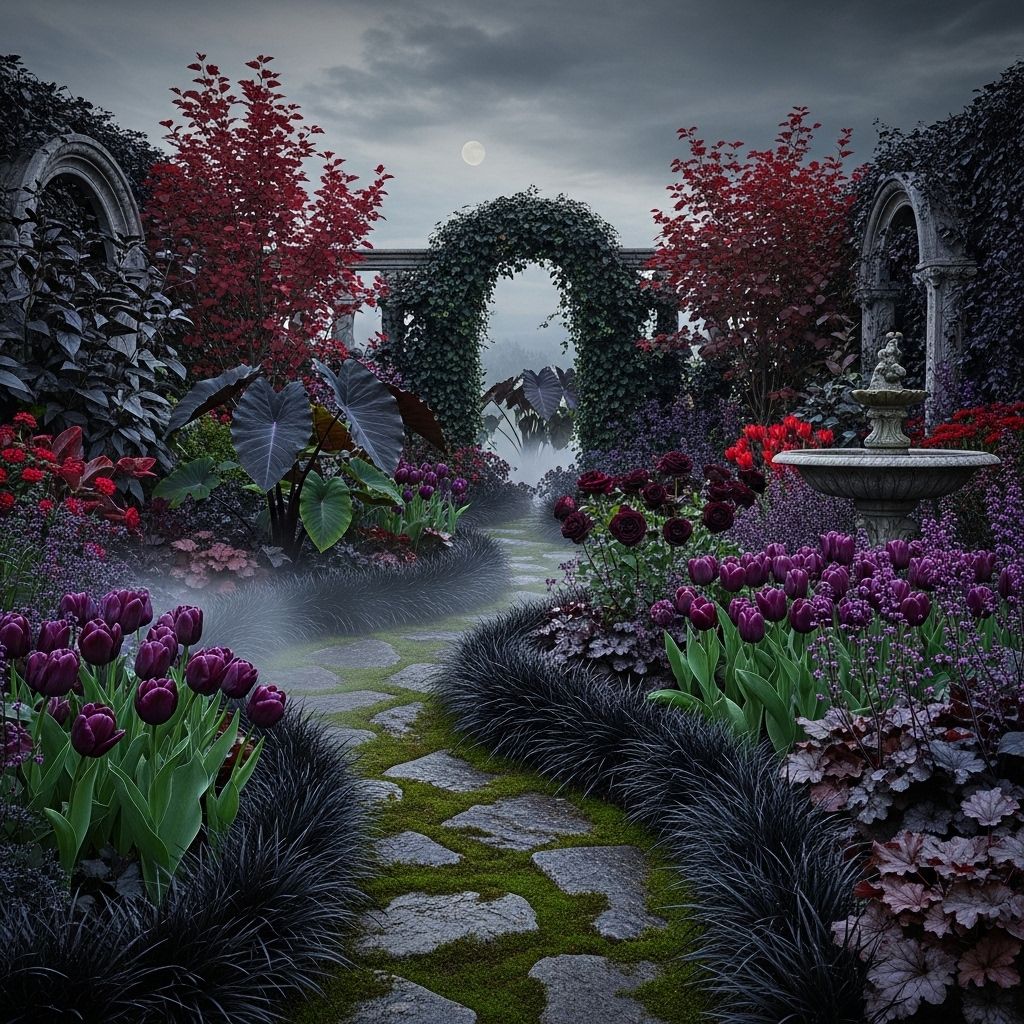41 Striking Plants for a Dramatic Goth Garden
Embrace bold foliage and dark blossoms for an endlessly atmospheric garden retreat.

Are you drawn to mysterious, dramatic, and eerie aesthetics? Bring that magic from your wardrobe or literature into your landscape with a goth garden. With their somber color palette, unique textures, and evocative forms, these gardens channel the spirit of the gothic: enchanting, powerful, and a little bit macabre. In this article, explore 41 plants—from annuals and perennials to shrubs and vegetables—perfect for your dark botanical dreams. Whether you’re a seasoned horticulturist or experimenting with your first spooky border, these selections promise to inspire and haunt, year after year.
What Is a Goth Garden?
A goth garden draws inspiration from gothic subculture, literature, and art, emphasizing dark, moody, or even sinister beauty. Rich purples and blacks, dramatic foliage, and unusual blooms dominate, often softened with silver, white, or deep crimson undertones.
- Color palette: Black, near-black, deep purple, burgundy, midnight blue, silver, and dark green.
- Plant selection: Foliage as important as flowers; textures, leaf shapes, and seed pods add intrigue.
- Themes: Graveyard chic, victorian mystery, haunted woods, or just a moodier take on cottage or woodland planting.
Now, let’s walk the shadowy path lined with the best plants for a goth garden.
Annual Flowers for the Goth Garden
‘Black Magic’ Bachelor’s Button (Centaurea cyanus ‘Black Magic’)
Deep maroon blooms on long stems. An edible annual that self-seeds.
Sun: Full sun
Height: 20-24″
Zones: 2-11Amazing Grey Poppy (Papaver rhoeas ‘Amazing Grey’)
Ghostly pale-lavender, smoky blooms that shimmer in sunlight, evoking a haunted field effect.
Sun: Full
Zones: AnnualFor those curious about the fundamentals of creating a goth garden, our article on unveiling goth gardening offers vital insights into style, layout, and plant selection that every enthusiast should explore.Black Hollyhock (Alcea rosea ‘Nigra’)
Tall spires produce deepest-maroon, almost black flowers—a dramatic backdrop plant.
Sun: Full
Zones: Biennial but often reseedsBlack Peony Poppy (Papaver paeoniflorum)
Fluffy, double blooms in a nearly black-burgundy. Reseeds and attracts pollinators.
Zones: AnnualBlack Prince Snapdragon (Antirrhinum majus ‘Black Prince’)
Velvety maroon to black blooms with dark foliage; great cut flower.
Sun: Full
Zones: AnnualBlack Mamba Petunia (Petunia x hybrida)
Sultry, inky black blossoms with a velvety texture. Eye-catching in containers and borders.
Zones: AnnualTo elevate your garden's contrast and drama, discover our stunning black and white flower ideas, showcasing 18 gorgeous varieties that will enrich your dark-themed landscape with striking appeal.Panther Phlox (Phlox drummondii ‘Panther’)
Intense near-black petals clustered en masse. Relatively compact for edge plantings.
Zones: Annual
Perennials and Biennials with Gothic Allure
Stinking Hellebore (Helleborus foetidus)
Finely divided, dark leaves that turn blackish-purple in winter. Spooky yellow cup flowers contrast the dark foliage.
Sun: Partial to full shade
Height: 1-2’
Zones: 5-9Black Scabiosa (Scabiosa atropurpurea ‘Black Knight’)
Near-black pincushion flowers float above wiry stems. Beautiful for bouquets or as dried pods.
Zones: Perennial in warm climates; annual elsewhereQueen of Night Tulip (Tulipa ‘Queen of Night’)
The classic black tulip; deep, rich burgundy so dark it appears black.
Black Iris (Iris ‘Before the Storm’ or similar)
Velvety petals of purple-black to near ink hues, stunning in iris beds.
Black Barlow Columbine (Aquilegia vulgaris ‘Black Barlow’)
Intricately doubled blooms in shades of jet and plum.
Chocolate Cosmos (Cosmos atrosanguineus)
Deep burgundy-brown flowers with a chocolate scent.
Obsidian Coral Bells (Heuchera ‘Obsidian’)
Dramatic, glossy, almost black foliage ideal for borders or containers.
Black Beauty Elderberry (Sambucus nigra ‘Black Beauty’)
Feathery, purple-black foliage and pink flower clusters add height and drama.
If you're looking to add an extra layer of sophistication, don't miss our selections of 17 deep and moody roses for a dramatic garden, perfect for enhancing the gothic aura of your space.Phantom Hydrangea (Hydrangea paniculata ‘Phantom’)
While not truly black, their massive ivory blooms with deep green stems add spectral contrast among darker plants.
‘Black Lace’ Elderberry (Sambucus nigra ‘Black Lace’)
Ferny, blackish leaves with pink flowers. Versatile in large borders.
Foliage Stars and Shrubs
Ace of Spades Potato Vine (Ipomoea batatas ‘Ace of Spades’)
Deep purple-black leaves, ideal for spilling from containers or ground cover.
Sun: Full to part shade
Height: Up to 10”Black Pearl Pepper (Capsicum annuum ‘Black Pearl’)
Ornamental black-leaved pepper with shiny black fruits that ripen to red.
Knight Rider Lily (Lilium ‘Knight Rider’)
Striking, glossy black blooms rising above midsummer foliage.
Purple Fountain Grass (Pennisetum setaceum ‘Rubrum’)
Graceful burgundy-purple leaves and flower spikes for late-season drama.
Vegetables and Edibles
Black Beauty Tomato (Solanum lycopersicum ‘Black Beauty’)
Produces the darkest tomato available, with deep purple-black fruit and savory flavor.
Black Hungarian Pepper (Capsicum annuum)
Dark, almost black peppers maturing to red. Adds gothic flair and spice.
Black Diamond Watermelon (Citrullus lanatus)
Obsidian-skinned fruit hides vibrant, juicy red flesh—unexpected and bold.
Dragon Tongue Beans (Phaseolus vulgaris)
Though more purple and speckled than black, the mysterious coloring fits with moody themes.
Ornamental Grasses, Vines, and Unique Oddities
Raven Zamioculcas (also known as ZZ Plant ‘Raven’)
Dark, glossy, almost black foliage makes an impact in shade or as a houseplant.
Diablo Ninebark (Physocarpus opulifolius ‘Diablo’)
Purple-black foliage provides an imposing backdrop for lighter flowers and plants.
Black Bamboo (Phyllostachys nigra)
Unusual black stalks make this bamboo a showstopper in modern or gothic landscapes.
Black Lace Elderberry (Sambucus nigra ‘Black Lace’)
Fine, cutleaf foliage in a deep purple-black hue. Beautiful as a specimen shrub.
Dark Bulbs and Tubers
Black Dahlia
Huge, near-black blooms that make a theatrical impact in late summer.
‘Black Hero’ Tulip
Double blooms of dark plum and black, echoing old world gothic glamour.
Bat Flower (Tacca chantrieri)
Sinister, bat-wing-like bracts in black or purple, with long trailing filaments. A true oddity for humid spots.
Black Calla Lily
Deep purple-to-black, elegant trumpet-shaped blooms. Great for containers or bouquets.
Building Your Goth Garden: Design Tips
- Layering is key: Use varying heights—from dark grasses to tall hollyhocks—to create depth and a sense of wild neglect.
- Contrast with silver, white, or chartreuse: Even the darkest features pop with the right highlights. Try Artemisia, Dusty Miller, or Ghost Fern to accentuate shadowy neighbors.
- Choose dramatic containers: Black urns, weathered stone, or cast iron add to the ambiance.
- Include gothic structures: Arbors, trellises, and old lanterns evoke haunted garden stories.
- Seasonality: Select plants for spring, summer, and autumn interest—let your gothic landscape shift like a storyline.
Table of Notable Goth Garden Plants
| Plant Name | Type | Main Feature | Zoning |
|---|---|---|---|
| Stinking Hellebore | Perennial | Black-purple leaves, yellow-green flowers | 5-9 |
| ‘Black Magic’ Bachelor’s Button | Annual | Deep maroon edible blooms | 2-11 |
| Queen of Night Tulip | Bulb | Deepest, velvety-black tulip | 3-8 |
| Black Barlow Columbine | Perennial | Double, dark flowers | 3-9 |
| Black Bamboo | Bamboo | Black culms, dramatic screens | 7-10 |
Frequently Asked Questions (FAQs)
What defines a goth garden?
A goth garden is defined by its dark color palette—black, near-black, deep purple, and burgundy—as well as dramatic shapes, textures, and a mysterious or moody overall ambiance.
Are goth gardens difficult to maintain?
Most goth garden plants are not harder to grow than standard varieties. Many selections—like Stinking Hellebore, Black Bamboo, or Queen of Night Tulip—are as resilient as their more colorful counterparts. Focus on your region’s hardiness and sun/shade requirements for best results.
Can goth gardens attract pollinators?
Absolutely! Plants such as bachelor’s buttons, poppies, and sunflowers draw bees and birds. Even dark-petaled flowers often have ultraviolet patterns to guide pollinators.
Which containers and structures work best for a goth garden?
Black urns, wrought iron, weathered stone, and vintage or gothic statuary all amplify the haunted feel. Use them as focal points amid your lush, dark plantings.
Do goth gardens only feature black plants?
No—effective design uses a mixture of dark with contrasting silver, white, and green. This contrast heightens the drama and helps darker plants stand out.
Further Reading & Inspiration
- Browse specialty seed catalogs for unique varieties.
- Explore local garden centers for new cultivars in almost-black hues.
- Consider mixing gothic themes with woodland, cottage, or modern design for a personalized twist.
Conclusion
With care in selection and placement, your goth garden will become a year-round masterpiece—rich with striking silhouettes, mystery, and the beauty found in shadow. Which of these 41 plants will anchor your own haunted oasis?
References
Read full bio of Srija Burman












